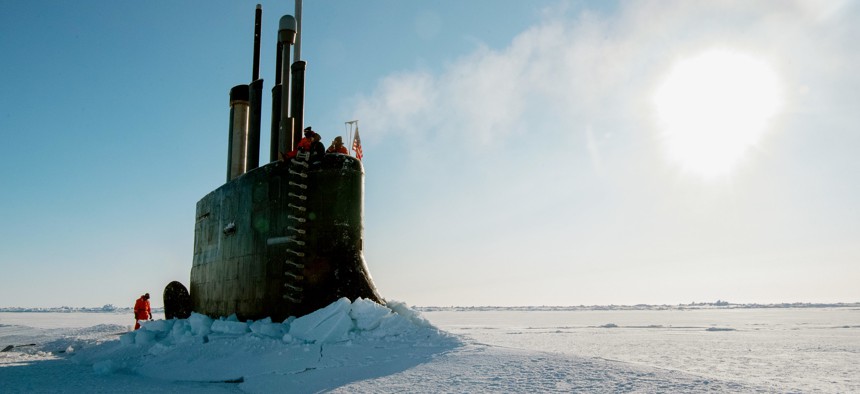
The Seawolf-class fast-attack submarine USS Connecticut surfaces through the ice in the Beaufort Sea as it participates in Ice Exercise 2018. U.S. Navy / Mass Communication Specialist 1st Class Daniel Hinton
In the Newly Noisy Arctic, Underwater Operations Are Getting Harder
Less ice means more ships, which means more problems for sonar operators and their skippers.
Underwater operations in the Arctic are becoming more challenging, in part because more ships are rumbling through the northern waters, a maritime transportation expert said Monday.
Within the last decade, the Bering Sea and Baffin Bay—near Greenland—have seen noise double during the summer months, an increase of 10 decibels, said Alyson Azzara, an international trade specialist at the U.S. Department of Transportation’s Maritime Administration.
“So that's important for the environment, for marine mammals, for the fish, for all of that. But it's also important for anything that's operating or listening or recording under the ice, under the water. And what does that mean and how does that need to change or how does that need to adapt? And these are all things that we need to be thinking about going forward,” Azzara said during a panel at the Navy League’s 2021 Sea Air Space convention.
The growth in shipping traffic is due to increased access to the region for longer periods of time during the open-water season, as well as more interest in things like natural resources—such as oil, gas, and rare earth minerals, she said.
Vice Adm. Andrew Lewis, the commander of U.S. 2nd Fleet, said keeping a U.S. naval presence in the Arctic is critical, as Russia continues to build up its own presence and China has shown growing interest, calling themselves a “near-Arctic nation.”
“We have to be present; otherwise, we’re going to cede the space to the Russians or somebody else in the future,” Lewis said during the event.
One way to be present is with submarines, which the U.S. and Russia use to travel under the Arctic ice. But Lewis said the increase in underwater noise is making it harder both to operate subs and to find them, and the problem is exacerbated by the fact that much of the Arctic is not mapped.
“It's difficult to understand how the sound operates, how sound propagates in the undersea, and that has a direct impact on our ability to understand the environment, which is kind of the first rule of warfighting,” he said.





